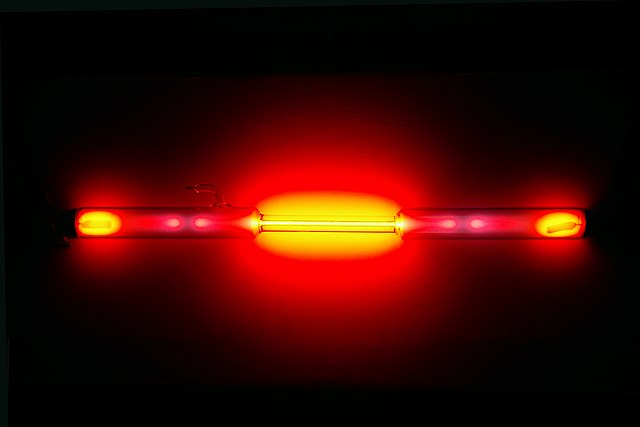Neon lighting consists of brightly glowing, electrified glass tubes or bulbs that contain rarefied neon or other gases. Neon lights are a type of cold cathode gas-discharge light. A neon tube is a sealed glass tube with a metal electrode at each end, filled with one of a number of gases at low pressure. A high potential of several thousand volts applied to the electrodes ionizes the gas in the tube, causing it to emit colored light. The color of the light depends on the gas in the tube. Neon lights were named for neon, a noble gas which gives off a popular orange light, but other gases and chemicals called phosphors are used to produce other colors, such as hydrogen (purple-red), helium, carbon dioxide (white), and mercury (blue). Neon tubes can be fabricated in curving artistic shapes, to form letters or pictures. They are mainly used to make dramatic, multicolored glowing signage for advertising, called neon signs, which were popular from the 1920s to 1960s and again in the 1980s.

A neon light art installation in Bangkok
The vicinity of Times Square, New York City, has been famous for elaborate lighting displays incorporating neon signs since the 1920s.
Piccadilly Circus, London, 1962
Gas discharge tube containing neon, which was first displayed by Ramsay and Travers; "Ne" is the symbol for neon, one of the chemical elements.
Neon is a chemical element; it has symbol Ne and atomic number 10. It is the second noble gas in the periodic table. Neon is a colorless, odorless, inert monatomic gas under standard conditions, with approximately two-thirds the density of air.
Neon
Neon gas-discharge lamps forming neon's element symbol
The first evidence for isotopes of a stable element was provided in 1913 by experiments on neon plasma. In the bottom right corner of J. J. Thomson's photographic plate are the separate impact marks for the two isotopes neon-20 and neon-22.
Neon sign in a Hamden, Connecticut, florist shop







